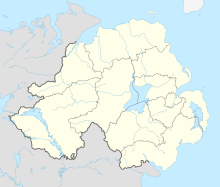
Armagh is the county town of County Armagh and a city in Northern Ireland, as well as a civil parish. It is the ecclesiastical capital of Ireland – the seat of the Archbishops of Armagh, the Primates of All Ireland for both the Roman Catholic Church and the Church of Ireland. In ancient times, nearby Navan Fort was a pagan ceremonial site and one of the great royal capitals of Gaelic Ireland. Today, Armagh is home to two cathedrals and the Armagh Observatory, and is known for its Georgian architecture.

The French Imperial Eagle refers to the figure of an eagle on a staff carried into battle as a standard by the Grande Armée of Napoleon during the Napoleonic Wars.

Geoffrey St. George Shillington Cather was a recipient of the Victoria Cross, the highest and most prestigious award for gallantry in the face of the enemy that can be awarded to British and Commonwealth forces. A soldier with the Royal Irish Fusiliers during the First World War, he was posthumously awarded the VC for his actions on 1 July 1916, during the Battle of the Somme.

Robert Morrow VC was an Irish recipient of the Victoria Cross, the highest and most prestigious award for gallantry in the face of the enemy that can be awarded to British and Commonwealth forces.

The Royal Irish Regiment is an infantry regiment of the British Army. The regiment was founded in 1992 through the amalgamation of the Royal Irish Rangers and the Ulster Defence Regiment. Their oldest predecessor; the 27th Regiment of Foot; was first raised in June 1689 to fight in the Williamite War in Ireland. Other notable regiments in their lineage include the Royal Inniskilling Fusiliers, Royal Irish Rifles and the Royal Irish Fusiliers.

The Royal Dublin Fusiliers was an Irish infantry Regiment of the British Army created in 1881, one of eight Irish regiments raised and garrisoned in Ireland, with its home depot in Naas. The Regiment was created by the amalgamation of two British Army regiments in India, the Royal Bombay Fusiliers and Royal Madras Fusiliers, with Dublin and Kildare militia units as part of the Childers Reforms that created larger regiments and linked them with "Regimental Districts". Both regular battalions of the Regiment fought in the Second Boer War. In the First World War, a further six battalions were raised and the regiment saw action on the Western Front, the Mediterranean, and the Middle East. In the course of the war three Victoria Cross were awarded.

The Grand Lodge of Ireland is the second most senior Grand Lodge of Freemasons in the world, and the oldest in continuous existence. Since no specific record of its foundation exists, 1725 is the year celebrated in Grand Lodge anniversaries, as the oldest reference to Grand Lodge of Ireland comes from the Dublin Weekly Journal of 26 June 1725. This describes a meeting of the Grand Lodge to install the new Grand Master, The 1st Earl of Rosse, on 24 June. The Grand Lodge has regular Masonic jurisdiction over 13 Provincial Grand Lodges covering all the Freemasons of the island of Ireland, and another 11 provinces worldwide.

The Royal Inniskilling Fusiliers was an Irish line infantry regiment of the British Army in existence from 1881 until 1968. The regiment was formed in 1881 by the amalgamation of the 27th (Inniskilling) Regiment of Foot and the 108th Regiment of Foot.

The Royal Northumberland Fusiliers was an infantry regiment of the British Army. Raised in 1674 as one of three 'English' units in the Dutch Anglo-Scots Brigade, it accompanied William III to England in the November 1688 Glorious Revolution and became part of the English establishment in 1689.

Enniskillen Castle is situated in Enniskillen, County Fermanagh, Northern Ireland. It was originally built in the 16th century and now houses the Fermanagh County Museum and the regimental museum of the Royal Inniskilling Fusiliers and the 5th Royal Inniskilling Dragoon Guards.

Sir Charles Norman Lockhart Stronge, 8th Baronet, MC, PC, JP, was a senior Ulster Unionist Party politician in Northern Ireland.
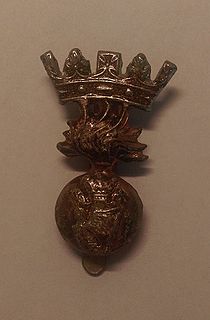
The Royal Irish Fusiliers was an Irish line infantry regiment of the British Army, formed by the amalgamation of the 87th Regiment of Foot and the 89th Regiment of Foot in 1881. The regiment's first title in 1881 was Princess Victoria's , changed in 1920 to the Royal Irish Fusiliers . Between the time of its formation and Irish independence, it was one of eight Irish regiments.

The Prince of Wales's Leinster Regiment was an infantry regiment of the line in the British Army, formed in 1881 by the amalgamation of the 100th Regiment of Foot and the 109th Regiment of Foot. The 100th Foot was first raised in 1858 and the 109th was first raised in 1853. Between the time of its formation and Irish independence, it was one of eight Irish regiments raised largely in Ireland, its home depot in Birr. It was disbanded with the Partition of Ireland following establishment of the independent Irish Free State in 1922 when the five regiments that had their traditional recruiting grounds in the counties of the new state were disbanded.
107 (Ulster) Brigade was based in Ballymena and was, most recently before its disbandment, the British Army Regional Brigade responsible for administering the Territorial Army within Northern Ireland.
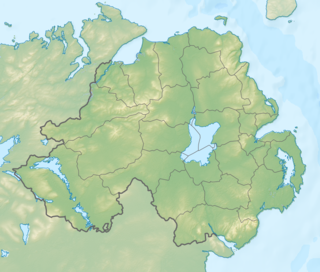
The Drummuckavall ambush was an attack by the South Armagh Brigade of the Provisional Irish Republican Army (IRA) on a British Army observation post in Drummuckavall, southeast of Crossmaglen, County Armagh, on 22 November 1975. The attack, which occurred along the border with the Republic of Ireland, resulted in the deaths of three British soldiers and underlined the inefficiency of conventional military skills to deal with the situation in South Armagh, prompting the deployment of the Special Air Service (SAS) in this area.
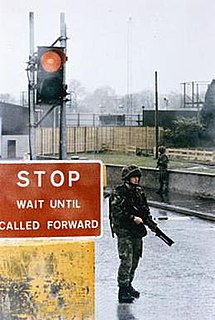
The attack on Cloghoge checkpoint was an unconventional railway bomb attack carried out on 1 May 1992 by the Provisional Irish Republican Army (IRA) against a British Army permanent vehicle checkpoint, manned at the time by members of the Royal Regiment of Fusiliers. The IRA's South Armagh Brigade fitted a van with wheels that allowed it to move along a railway line. A large bomb was placed inside the van, which was then driven along the railway line to the target. The explosion killed one British soldier and injured 23 others. The compound, just north of the village of Cloghoge in County Armagh, on the southern outskirts of Newry, was utterly destroyed.
In countries whose armies are organised on a regimental basis, such as the army of the United Kingdom, a regimental museum is a military museum dedicated to the history of a specific army regiment.
Major David Graham Shillington PC(NI) was an Ulster Unionist politician.
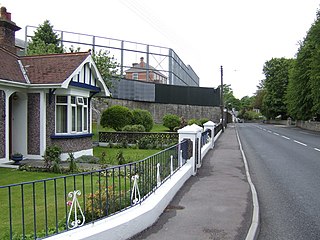
Gough Barracks was a military installation in Armagh, Northern Ireland.

